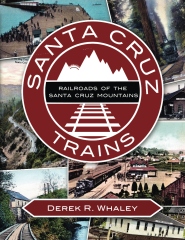

Tanana Valley Railroad.
F alcon Joslin and Martin Harrais, entrepreneurs living in Dawson, Yukon Territory, Canada, learned of the gold strikes in the Chena and Chatanika river basins. Residents of the area needed a dependable, year-around means of transportation to move people and supplies to and from the mines. In 1903, Joslin and Harrais traveled to the Tanana Valley to evaluate the possibility of building a railroad from the Tanana River to Fairbanks and the gold fields. Returning to Dawson, they laid plans and secured financial backing from British investors who had financed several small industrial railroads in the Dawson area and the White Pass And Yukon Route.
Construction began in late summer of 1904 at Chena with the erection of a sawmill, rail yard and other support structures. A locomotive was purchased second hand from Coal Creek Coal Company, and moved to Coal Creek on August 4th. Departed Coal Creek on June 5, arriving at Fairbanks on July 4 1905. The first 14 miles of railroad (22.5km) was completed by August 1905.1 Progress was made pushing the line further from Chena to Gilmore (21mi) and from Fairbanks to a place called Fairbanks Junction 5mi to the west. Despite this the line struggled to extend further.
On December 12, 1906, the railroad was reorganized as the Tanana Valley Railroad. To further aid the railroad in construction Congress passed a tax act to relieve the railroad from paying taxes in April 1907.2 On May 15, 1907, construction began on an extension of the line to Chatanika. The new company optimistically hoped to connect with Alaskan mining camps in the region. This included a branch north through the Yukon to Dawson City and an extension west from Fairbanks to Nome, some 600 miles away. Instead, mining strikes around Dome, Vault, Ridgetop and Olnes brought the railroad up the Fox Creek Valley to reach the new communities. On September 29, the construction crew reached Chatanika after building 19.2 miles (30km) of railroad in four months.
The railroad was profitable in the first few years of operation. As new forms of transportation entered the region, revenues began to drop off. The railroad struggled through the 'teens until it was forced to declare bankruptcy in 1917. On November 1st, the TVRR was sold at a bankruptcy sale for $200,000. It was resold to the Federal Government and Alaska Engineering Commission (AEC) for $300,000 on December 31, 1917 and became the Chatanika Branch of the Alaska Engineering Commission Railroad. The AEC was engaged in constructing the Alaska Railroad from the south.
The AEC constructed a 47mi (75km) branch from Happy Station to Nenana, the site of a proposed crossing of the Tenana River. As this new line built south, the standard gauge Alaska Northern Railroad was building north towards Nenana. This new section was completed, with crews building north from Nenana and south from Fairbanks, on November 7, 1919. By May 8 1920, the standard-gauge reached Happy Station and track to Fairbanks was dual gauged shortly thereafter. In early June, standard gauge track was extended to the northern terminus in Fairbanks. Through traffic from Fairbanks to Seward began immediately, even though the "official" completion of the railroad didn't occur until July 15.
In 1923 the line from Chatanika to Nenana was converted to standard gauge, leaving only the segment from Junction (College) to Fairbanks 36” gauge. Competition with motor vehicles on the developing road system cut into the profitability of the branch. The Alask Railroad decided to close down the line and on August 1, 1930. The remaining narrow gauge equipment and track was removed in 1931.
Locomotive #1 was donated to the city of Fairbanks in 1931 and placed on display at the Alaska Railroad depot. It was later moved to Alaskaland and displayed for many years. In 1991 restoration began on the locomotive. On July 24 1999 the locomotive returned to service now 100 years old and operates on special occasions. Baldwin 4-6-0 locomotive #152 returned to the lower 48 in the 1930s and sold to a junkyard in Stockton CA.. Hal Wilmunder purchased the locomotive for operation on his Antelope Western Railroad in Roseville, CA. In the 1970s the locomotive briefly operated on the Camino Cable and Northern in Camino, CA. Before being sold to the Huckleberry Railroad near Flint Michigan.
2. United States Congress; Act to relieve Tanana Valley Railroad in Alaska from Taxation. March 2, 1907.
Bibliography
Hilton, George W., American Narrow Gauge Railroads, Stanford, CA: Stanford University Press, 1990. ISBN: 0-8047-2369-9.
Alaska's Tanana Valley Railroads By Daniel L. Osborne
History from Tanana Valley Railroad Friends
Alaska Engineering Commision History
Reference Material Available Online:
Articles.
"Furthest North in Railroading" by Emil E. Hurja. Technical World Magazine Vol XX. October, 1913. No. 2
The Progress of the Alaskan Railroad. Railroad Men Vol XXII. July 1919.
Reports.
Nenana Coal Field Alaska by G. C. Martin. United States Geological Survey Bulletin #664, 1919.
Publications.
Alaska Railroad Record Vol IV, Issues 1 - 34.
The Alaskan Engineering Commission. Its History, Activities, and Organization.
Maps.
The Route of the Tanana Valley Railroad for Google Earth by Gabe Emmerson.
Photographs.
Collected Tanana Valley Railroad Photographs.
Images collected from private collections, libraries and historical societies.
Organizations:
Friends of the Tanana Valley Railroad.
Alaska \ Tanana Valley Railroad


